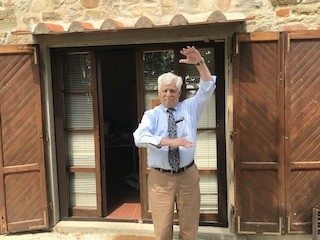
Innovation for Social Change
This is the first of four blog posts on innovation. Like the series I just finished on responses to the COVID-19 crisis, innovation is important in its own right. That said, I’m focusing on it now because I’m thinking of writing a book on a paradigm shift in American social and political life and am also using the series to focus my own thinking and define the issues I will have to research should I decide to write what my grandson would call a chapter book.

Innovation for Social Change
I will be dedicating my blog posts during June 2020 to how we could and should innovate in dealing with the COVID-19 crisis and, now, the protests following the death of George Floyd. My goal is to refine my own thinking and develop ideas for what peacebuilders and others can do in the coming weeks and months rather than what we could and should do right now. Others can do that far better than I can.
Here is a schedule:
June 5 Innovation for Social Change
June 12 Working on the Edge
June 19 Virtuous Circles
June 26 Innovating Yourself
Business as (Un)usual
 When the Alliance for Peacebuilding named me its chief (and only) innovation officer, the title made sense. I’ve never been satisfied with the status quo and always wanted to shake things up for the better. That was true in my first job as a camp counselor when I introduced instructional programs in playing bridge (yes, I was a dork) and served as the religious emphasis director at a YMCA camp, even though I was Jewish.
When the Alliance for Peacebuilding named me its chief (and only) innovation officer, the title made sense. I’ve never been satisfied with the status quo and always wanted to shake things up for the better. That was true in my first job as a camp counselor when I introduced instructional programs in playing bridge (yes, I was a dork) and served as the religious emphasis director at a YMCA camp, even though I was Jewish.
The only problem was that I hadn’t really thought through what innovation meant in general or for peacebuilding in particular.
Over the last five years, I’ve learned a few things which I want to share in these posts which I want to use to goad peacebuilders and others to dramatically shift the way we work so that we can have the kind of social and political impact we have always craved. That’s particularly important today because we find ourselves facing a pandemic and economic collapse. In the United States, we can add racial and political unrest to that already challenging mix.
To be honest, the situation we face in the United States and around the world is stark. The stakes are high. Add any other dire cliché you want here.
I have begun illustrating theose stakes with the three pictures in this section, which seem to be more evocative when I can present them live. The first depicts peacebuilders’ impact when the field as we know it today was created in the early 1980s. the second suggests how much (or little) that impact has grown. The third one shows how much we still need to grow.
If I’m right, business as usual just won’t do.
In the previous four posts, I laid out some broad outlines of what our response(s) to the current crisis should be like., though you should note that I wrote them all before George Floyd was murdered. Now, I want to home in on the kinds of innovative practices we will need.
 As was the case with the first set of posts, I will be rather abstract at first. But don’t worry, the next three will get to specifics very quickly.
As was the case with the first set of posts, I will be rather abstract at first. But don’t worry, the next three will get to specifics very quickly.
What Innovation Is(n’t)
That starts with innovation itself.
Innovation, of course, is a key concept in economics and, now, most other social science disciplines. Basically, innovative products provide new goods or services that satisfy unmet needs. One classic example is the iPhone (or Android if you are so inclined) that lets me surf the web, send messages in a variety of formats, attend Zoom meetings by the thousand wherever you are, watch Yankee games (when and if we ever have them), and, lest I forget, make phone calls.
In that sense, an innovation is not necessarily or simply something that is flashy and cool. At least in the areas I’m interested in, it has to be what some analysts call a disruptive innovation that dramatically alters the way we do things and does so for the better.
We actually know a fair amount about how innovation occurs which I’ll be exploring in more depth in the rest of this post and the ones that will follow in the first three weeks which I’ll anticipate here.
Beyond the BS
Before doing so, be sure to take one idea on board.
Innovation shares one less than desirable feature with other ideas that have made their way into pop culture, including empathy, resilience, and self-awareness.
 As David Rowan puts it in his recent book Non-Bullshit Innovation, there’s a lot of bs out there. As former editor of the UK edition of Wired, Rowan knows all too well that many of the companies and executives that claim to be innovative use the term primarily as window dressing or to describe change that falls far short of dramatically altering the ways we do things for the better.
As David Rowan puts it in his recent book Non-Bullshit Innovation, there’s a lot of bs out there. As former editor of the UK edition of Wired, Rowan knows all too well that many of the companies and executives that claim to be innovative use the term primarily as window dressing or to describe change that falls far short of dramatically altering the ways we do things for the better.
He begins his book by discussing meetings he had had with people who wrapped the term innovation around all sorts of other terms (including empathy, resilience, and self-awareness) and ended up with amount to little more than what one of my friends in the organizational development field refers to as rearranging the deck chairs on the Titanic.
As he put it:
Too often what is celebrated as innovation inside large organizations in in face “innovation theatre”—a box-ticking, public-relations-led, self-reassuring alternative to radical changes in mindset and culture, just as “security theatre” at the airport does little to increase actual security but does annoy passengers as per the protocol.
If, like me, you are a peacebuilder, that kind of BS won’t do.
If you are focused on the pandemic, the recession, and/or the racial divides in the US, rearranging the deck chairs on the Titanic won’t do.
If you are a change agent on any ssue, you know that you need disruptive new ways of thinking and acting that actually lead to profound change both now and in the longer run.
So, I keep finding myself going back to the criteria I’ve already used twice here. I’m only interested in the kind of innovation that:
That, in turn leads to two broad but often misleading descriptions about how innovation occurs because of a third common denominator that all such breakthroughs share. Those common denominators, in turn, lead me to the posts I’ll be writing in the three weeks to come. I’ll at least hint at that in the three sections that follow.
Moonshots
Many people assume that innovations have to be dramatic changes that seem to emerge out of nowhere and arrive with a splash—just like the iPhone. That leads many of us think of innovations as moonshots or as Safi Bahcall calls them, loonshots. As he says them, the most spectacular innovations amount to what physicists call phase transitions which occur when water suddenly boils or freezes.
On one level, Bachcall is right.When I woke up on January 9, 2007 I did not know that there was such a thing as the iPhone. That afternoon, I knew I had to have one.
My life is filled with new things that changed my life in a blink of the clichéd eye. As a child, I got the brand new Salk and Sabin polio vaccines. I remember the day my mother came home with one of the first Polaroid cameras that introduced instant photography to the world. As an adult, new technologies have changed my life in unprecedented and unexpected ways from my first Mac in 1984 to the way Zoom has made it possible for me to continue working with people around the world this year. Not all of them were good, of course. I vividly remember what I was doing the day President Kennedy was shot and the airplanes flew into the twin towers in New York.
But there’s always more involved. If we dig just a bit deeper into those loonshots, we realize that they don’t actually appear out of nowhere. Bahcall sees that in the subtitle he gives his book, “how to nurture the crazy ideas that win wars, cure diseases, and transform industries.”
Not all crazy ideas reach fruition. Not all crazy should reach fruition. As he points out, there’s a lot more than luck involved in those rare moments when iPhones and Polaroid cameras get introduced to the world.
 I’ve sent the last few years looking for moonshots through what I think of as a mini-version of what John Hagel and John Seely Brown call an edge lab like the one they built at Deloitte. They help companies create units that look outward from the “edge” of their business to identify new and productive ideas. Now, I’ve realized that working from the edge can involve taking ideas out beyond the edge of your field and begin to have an impact on the rest of the world as I hope we peacebuilders can do in confronting the current crisis shaking the world.
I’ve sent the last few years looking for moonshots through what I think of as a mini-version of what John Hagel and John Seely Brown call an edge lab like the one they built at Deloitte. They help companies create units that look outward from the “edge” of their business to identify new and productive ideas. Now, I’ve realized that working from the edge can involve taking ideas out beyond the edge of your field and begin to have an impact on the rest of the world as I hope we peacebuilders can do in confronting the current crisis shaking the world.
Adjacent Possible
The second broad understanding of innovation has roots in evolutionary theory and leads us to an almost totally different misconception about how and why innovation happens. As we all learned (and perhaps forgot) in high school biology, physical evolution is a slow and unintentional process that unfolds over generations.
Among other things, evolutionary scientists talk about species evolving through the adjacent possible. Species do not make dramatic changes. Instead, the make incremental changes on the basis of what is possible to them at a given moment. In the case of genetics, that involves the kinds of changes that can occur as a result of adding a mutation or other alteration that then becomes dominant in generations to come. That has helped us understand, for example, why people in Europe overcame lactose intolerance or developed lighter skin over the course of the last few millennia or so.
For our purposes here, the key is to think not in terms of physical evolution, but social or mental evolution. We can’t do much to either control or speed up how we change physically. We can, however, do so socially. We can be intentional about how we choose from among our adjacent possible options and then build on those choices—especially at moments like the one we are in today.
That, too, need not be left to chance as is normally case with genetic mutation and other physical forms of evolution. We can plan at least parts of our social evolution as I will argue in the third post which will consider creating, sustaining and expanding virtuous circles rather than the vicious cycles which seem to dominate our lives in 2020.
Now, that would surely be innovation of the highest order even if it doesn’t occur in one fell swoop. Whether it’s the development of the human brain itself or any of its major accomplishments, like democracy or religion or rock and roll, innovations that make a difference on an evolutionary scale take time and a lot of it..
It All Takes a Lot of Work
That leads to a third and frequently overlooked common denominator that all innovations share. They don’t come quickly or easily, especially those that seem to be the product of remarkable genius, like the iPhone and its iconic mastermind, Steve Jobs.
One of the things I’ve learned from my five years as a one person Edge Lab is that lasting innovations are never the work of a solo genius whose ideas magically get put into practice. They are created by teams who make tons of mistakes along the way. The story is told of James Dyson and his colleagues who tried more than 550 prototypes before they got the vacuum cleaner that bears his name right. Then, they have to make the innovation stick. Readers of a certain age will remember the technologically superior Beta videocassette system which flopped in the market place. Or today, why is it that Zoom succeeded in cornering the video teleconferencing market in 2020 leaving earlier competitors like GoToMeeting and their similar products in the dust?
I’ve learned another thing from my time thinking about innovation in the last few years. When I limit myself to the innovations that mesh with my value system, I see another common denominator which I’ll focus on in the final post.
Most of them emerge from what are often referred to as purpose driven organizations. Typically, they share what social psychologists call a superordinate goal that can only be reached when everyone involves works together. Most, too, have leaders who learn how to leave their egos and even their pocketbooks at the door are manage their teams by mirroring those superordinate goals and higher purposes in everything they do.
So, as I think about the kinds of innovations that can help us #buildbackbetter from the COVID-19 epidemic and from the political turmoil the United States is going through, we are going to have to work hard and we are going to have to base our actions on the values we hope to see enshrined in public policy in the decades to come.
Next Time
The next post will begin laying this vision out in more detail. I’ll spend more time laying out what Hagel and Brown mean by an edge lab, Then, I’ll explore some of the examples I’ve learned about that we peacebuilders should consider incorporating in our own work. After that, I’ll turn around and suggest the kinds of things that we peacebuilders have learned which could and perhaps should be adopted by our friends and allies who work in other spaces.
The views and opinions expressed in this article are those of the author and do not necessarily reflect the official policy or position of the Alliance for Peacebuilding or its members.
Also published on Medium.

